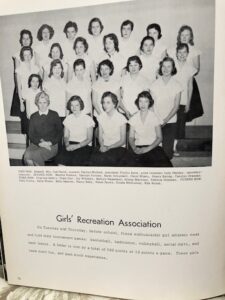Why we needed Title IX before 1972

The fiftieth anniversary of Title IX, a landmark law requiring gender equality in schools receiving federal funds, reminded me of how little opportunity to play sports most females of my generation had. (Title IX changed much more than sports, but that’s another story.)
In my one-room school with roughly a dozen students in grades one through eight, we had no organized physical education program for girls or boys. We played together at recess and noon, mostly baseball or games involving some form of tag. Our entire sporting equipment consisted of two bats, a softball, a baseball, and a volleyball (used for playing handy-over, with half the school on one side of the coal shed and half on the other).
In ninth grade, as I wrote in The Feedsack Dress, the most familiar sport to country kids—and the least played in girls’ P.E. class—was softball. By the time I learned the basic skills of an exotic game like deck tennis (played much like volleyball but with a hard rubber ring), a new game popped up. I added little to my homeroom’s intramural teams.
Neither my senior high school nor college in Kirksville, Missouri, fielded girls’ teams that competed with other schools. Neither had a swimming pool, and the high school had no playing field or tennis courts for girls. High school P.E. classes met in the basement gym. There we did boring calisthenics and played deck tennis, aerial darts, badminton, volleyball, and basketball. I was surprised to learn I had lettered my senior year (rare for a girl). I did it by recruiting the school’s best players for my intramural teams. If my memory is accurate, we won all the tournaments. The only mention of girls’ sports in the high school yearbook was the page above, which shows the members of the Girls’ Recreation Association (I’m second from left on the front row).
The college’s program offered little more than the high school did, though I did learn to play table tennis and jump on a trampoline. My athletic high point: The women’s P.E. Department (two women) let me substitute a softball elective for a required calisthenics course. As a grad student at the University of Missouri, I saw no opportunity to participate in any sports. One woman among several men in the renowned journalism school aspired to be a sports writer.
Finally, during Peace Corps training at Georgetown University, I received introductions to swimming, soccer, and cross-country running. My physical education consisted of appetizers but no main course.
The real national awakening to the potential of women’s sports took place in September 1973, more than a year after Title IX, when Billie Jean King took down Bobby Riggs in the Battle of the Sexes. She changed not just tennis but the recognition of women as athletes. She has continued to push for equal pay and power on the court and off ever since.
Even with the much greater (though not equal) opportunities today, I wouldn’t have become a great—even a good—athlete, but several of my classmates could have. And school would all have been more fun.
Equal opportunity, wherever you find it, makes life less frustrating and more rewarding.
—Carolyn Mulford
